Selection and preparation of parsley for harvesting
In summer, a lot of greens grow in the garden, which makes dishes tasty and aromatic. In winter, the situation with this product is more complicated - it is expensive and can be grown using harmful fertilizers. Preparations will help to bring a piece of summer into soups and main courses during the cold season.
The parsley harvest is often abundant - in such a situation, the question is how to quickly process the greens before they wilt. This problem can be solved by salting for the winter.
Preparing parsley and salt for the winter is not burdensome and even inexperienced housewives can do it. Both the greens themselves and their roots are suitable for long-term storage.
Preference is given to herbs grown in our own garden. They collect greens during the day, in dry sunny weather, when the dew has disappeared. For harvesting, choose fresh young branches with delicate foliage.
Advice. For long-term storage, parsley is collected in June before the plant blooms.
Housewives who do not have their own plot can harvest store-bought or market greens. The main thing is that the bunch is free of yellowed leaves, fresh and elastic.
Parsley paste
To stock up on parsley for making sauces, it is chopped and mixed with vegetable oil.
- Wash and dry the desired amount of parsley, trim the stems. For the preparation you will only need leaves.
- The washed dried greens need to be minced and divided into small portions (one-time use). In order not to defrost large pieces of frozen parsley each time (re-freezing - defrosting is not recommended, the parsley becomes watery and soft), it is convenient to store it in small molds (as for freezing ice).
- Mix parsley with a small amount of salted water or vegetable oil. Parsley in oil - ready-made sauce.
Instead of a meat grinder, you can use a blender.
How to prepare parsley with salt
Chopped herbs mixed with salt retain their taste and aroma well. You can store green mixtures in the refrigerator. Both branches and roots of parsley are suitable for pickling.
Before pickling, the greens are carefully sorted and yellowed, limp and rough parts are removed. The green part of the herbs is harvested separately from the roots.
For pickling, it is better to use 0.5 liter jars. The smaller the container, the better the greens will be salted in it.
Ingredients, proportions
To prepare you will need:
- 500 g chopped greens;
- 100 g coarse salt.
The ratio of greens to salt should be 5 to 1. It is better to use coarse, non-iodized salt. If you use small ones, the mixture will not be salted well and its shelf life will be reduced.
Step-by-step instruction
Preparing herbs is not difficult. For long-term storage it is important that the material is clean. Since the mixture is not sterilized, store it in the refrigerator.
The algorithm for preparing the workpiece is as follows:
- Rinse the plants well with running water and dry.
- Finely chop the greens.
- Remove large stems.
- Grind the greens with salt; the parsley should release its juice.
- Prepare a jar for the preparation.
- Sprinkle a thin layer of salt on the bottom of the container.
- Place parsley in a jar and compact well.
- Sprinkle a layer of salt on top of the greens.
- Close the jar and store in a cool place.
Advice. To prevent greens from being bitter, soak them in cold water for 30 minutes before cutting.
To pickle parsley root, it is first peeled and then grated.
The preparation can be used after a few days, but it is better to do this in winter, when there is a real need for aromatic and vitamin-rich greens. This way you can preserve not only parsley, but also celery, cilantro and other herbs.
Pickle parsley for the winter in the refrigerator
The ingredients in this recipe should be taken in a 4:1 ratio; this amount of ingredients allows you to get a mixture with a good combination of taste and shelf life. Moreover, it is not at all necessary to cut the greens; you can use whole sprigs, and before using, you just need to wash the sprigs in water and get rid of excess saltiness.
Required ingredients:
- Parsley – 400 grams;
- Salt – 100 grams.
How to pickle parsley for the winter:
- Wash the greens, separate the soft branches from the rough stems, do not cut the pulp, just divide it into branches so that the salt is then distributed between them;
- Pickling jars can be sterilized, or you can simply pour boiling water over them, since the twists will be stored in a cold place, it is not necessary to sterilize the jars, just rinse well and scald with boiling water. When using jars, it is important that they are completely dry;
- The pulp is placed in previously prepared glass jars or other containers, sprinkled well with salt, stirred so that the grains are well distributed and the mixture is evenly salted. You can mix the pulp with salt in a large separate pan and place the ready-made mixture into prepared containers;
- You can close the jars with ordinary plastic lids and put them in a cold room;
- Such branches can subsequently be used as a decoration for finished dishes, and the chopped pulp can be added as a dressing.
Other pickling recipes in a jar
Parsley goes well with other herbs and vegetables. Housewives can prepare vitamin complexes that add variety to lean soups, fish and meat dishes.
Important! When using the product when preparing soups and main courses, consider the amount of salt it contains. The main dish will have to be salted less.
With dill
The peculiarity of preparing these herbs is that they need to be salted separately, otherwise they will lose their individual taste and aroma.
For salting you will need:
- 0.5 kg dill;
- 0.5 kg parsley;
- 250 g salt.
The greens are washed and dried well. Then they are cut alternately and placed in two different bowls, into which 125 g of salt are poured. After the herbs have stood for a while, they are mixed and placed in jars, compacting well. You can sprinkle a small layer of salt on top of the mixture.
With vegetables
Together with parsley, you can pickle carrots, tomatoes, green onions, celery and dill. This preparation is used for preparing soups, main courses and salads.
Will need:
- 1 kg parsley;
- 1 kg dill;
- 1 kg leeks;
- 1 kg carrots;
- 1 kg of tomato;
- 0.5 kg of celery;
- 1 kg salt.
Recipe:
- Wash the greens and chop finely.
- Peel the carrots and cut into small pieces or grate.
- Wash the tomatoes, remove the stems and cut into thin slices.
- Mix the greens with salt and mix well, compacting.
- Place in the jar in layers: greens, carrots, herbs, tomatoes, etc.
- Once the container is filled, it is closed with a lid or parchment paper secured with an elastic band or thread.
With celery
Celery is useful, but does not last long. To extend its shelf life, it can be salted along with parsley and dill.
Ingredients:
- 250 g parsley;
- 250 g dill;
- 250 g celery;
- 250 g salt.
Wash the parsley and dill, remove the rough stems and cut into 1.5-2 cm branches. Peel the celery, rinse and cut into pieces 2 cm long. Mix the ingredients and add salt. Divide the mixture into jars and leave to infuse for a couple of days. During this time, the workpiece will decrease in volume and release juice. After this, you can add the mixture to the container and close the lid. The mixture is stored in a cool place or refrigerator.
With garlic
Garlic arrows are used to prepare a spicy soup dressing.
You will need:
- 160 g parsley;
- 160 g dill;
- 160 g garlic arrows;
- 70 g salt.
Sort the greens, wash, dry and finely chop. Then place in a dish, add salt and stir. Place in jars, compacting well. It is better to drain the released juice and use it immediately, as it tends to quickly acidify.
How to pickle parsley in a jar for the winter
You can buy parsley in the store at any time of the year, and if you have your own garden plot, you can stock up on the greens. The pickling method is perfect for this; when used, the greens remain healthy and do not lose their appearance and aroma. In addition, all you need for cooking is leaves and salt.
Required ingredients:
- Parsley – 300 grams;
- Salt – 3 tablespoons.
How to salt parsley in a jar:
- The leaves need to be sorted well, washed, and thick stems removed;
- In order for the leaves to dry, you need to spread them on a flat surface in a thin layer, the best thing is to leave the leaves overnight, they will dry well, and in the morning you can continue cooking;
- After this, you need to roll the leaves into a roll and cut them, so the mass will be cut into thin strips and salted well;
- Directly on the board on which the pulp was chopped, add salt to it, mix well, grind with crystals, as when kneading dough;
- Glass jars must be washed with soda, sterilized, placed upside down to dry completely, and only then can they be used for preparations;
- It is necessary to spread the resulting mass into prepared jars and compact it;
- All that remains is to close the containers with lids, you can use both polyethylene and iron ones, the most important thing is that the lid closes tightly and air does not pass inside;
- After closing, the jars can be put away for permanent storage. Since the mass has not been boiled or sterilized, there is a possibility of its spoilage, so such twists should be stored in a cool place. A cold cellar or refrigerator is ideal.
Parsley can complement any dish, especially if it contains meat or fish. Of course, you can’t do without salted greens when preparing vegetable salads or stews. Therefore, it is worth preparing a sufficient amount for the whole winter and eating almost fresh parsley.
Other harvesting methods
In addition to pickling, there are several other ways to keep parsley fresh for many months.
Drying
You can dry parsley branches and roots. You can prepare it this way:
- in the oven;
- electric dryer;
- microwave;
- convection oven;
- naturally.
First, the greens are washed well with running water, then shaken off and laid out on towels. As soon as the moisture is absorbed into the material, the parsley is chopped randomly, removing coarse stems.
If a dehydrator or electric dryer is used for drying, the greens in whole or crushed form are placed on a tray and the temperature is set to 40-50°C or the “For Herbs” mode. Higher levels will lead to loss of vitamins.
Drying time depends on the power of the device, air humidity, the type of herbs and the method of cutting them. To ensure uniform drying, trays with material are swapped every 1.5 hours. On average, parsley is dried for no more than 5 hours. If the device has a good fan installed, the process will go faster.
Those who do not have an electric dryer can use an oven. Place the prepared parsley on a baking sheet lined with baking paper. The paper on which the greens are placed should not be oiled.
The baking sheet is placed on the top shelf, the heating temperature should be 45-50°C. It is advisable to leave the oven door ajar. Drying takes 5-6 hours, the greens need to be checked from time to time.
Reference. To speed up the process, chop the parsley and spread it on a baking sheet in a thin layer. Drying will take 1.5-2 hours.
The microwave is also suitable for drying parsley. Place the herbs on a flat dish lined with a napkin or on a paper plate. The oven is turned on at full power for 2 minutes. After the readiness signal sounds, the greens are inspected and, if necessary, the procedure is repeated. Housewives advise inspecting parsley every minute of drying.
Chopped parsley can also be dried using an air fryer. The grass and roots are placed in the equipment, its door is not closed to allow air circulation. The temperature is set at 40-45°C, the power is maximum. To dry the branches, 20 minutes are enough, for the roots it will take 40 minutes.
The easiest way to dry parsley without additional equipment is naturally in bunches or chopped form. The greens, washed and dried from moisture, are tied in bunches and hung with the foliage down in a ventilated room.
You can also spread the parsley, whole or chopped, on paper in a dry place. The thickness of the layer of greenery should be no more than 1 cm. The drying room should not be exposed to direct sunlight so that the grass does not turn yellow. To ensure uniform drying, the material is stirred from time to time.
Drying naturally can take 5-14 days depending on the type of greens, how they are cut and weather conditions.
Parsley root is thoroughly washed with a brush before drying. Then it is cut into thin circles or strips and placed in an electric dryer or oven. Drying naturally produces a dried product.
Freezing
Only parsley is suitable for freezing . It is harvested in bunches or in a crushed state, depending on the purpose. Whole sprigs of parsley are used to decorate dishes, and chopped parsley is used to prepare sauces.
To freeze herbs in a bunch, wash them thoroughly and dry them on a towel. Then they are laid out in portions into bags. Chopped parsley is frozen in the same way. The greens are cut into large or small pieces and stored in the freezer.
Important! Thawed greens quickly lose their appearance, so they should not be frozen in one large bag.
Experienced housewives have adapted ice cube trays for freezing parsley. This preparation is convenient to use - one cube is suitable for one serving of the dish. The finer the material is cut, the easier it is to place it in the mold. For convenient storage and use, you can add a small amount of water to chopped parsley.
If there is a lot of greens, they are crushed in a blender and then distributed into molds. It is important to remove all rough parts of the plant. This preparation is used for making smoothies and sauces.
In oil
Parsley frozen in molds can also be filled with vegetable oil. Preference is given to olive oil - it better preserves the aroma of greens.
Refined sunflower oil is also used to prepare parsley in jars. After the greens are washed, dried, chopped and tightly placed in containers, oil is added to them. It is important to fill it to the top of the jar. To better fill the container, shake it up and turn it in different directions. This will allow the oil to completely cover the greens in the jar and displace any air bubbles.
Pickling
Only parsley roots are suitable for pickling.
For the marinade you will need:
- 4 tbsp. water;
- 1 tbsp. 9% vinegar;
- 0.5 tbsp. Sahara;
- 1-2 tsp. salt;
- 4 cloves garlic, chopped;
- 2 bay leaves;
- 5-7 black peppercorns.
Instructions for pickling parsley:
- Pre-rinse the material and dry it.
- Cut into slices or cubes.
- Place in salted boiling water for 2-3 minutes.
- Drain in a colander.
- Place in ice water for 30 seconds.
- Drain the water and place the root into jars.
- Pour boiling marinade over.
Freezing parsley
An equally effective way to prepare greens for the winter is freezing. The culture retains the entire supply of nutrients, thereby helping to support immunity in the middle of winter. Freezing plants will require very little time and effort. There are 3 ways, which one is the best, the hostess herself will decide.
In the package
All you need is parsley. Quantity is not limited. The leaves are washed well, sorted and dried.
If the greens sit for more than 30 minutes, they will begin to wilt. This will complicate the preparation process.
Drying using a towel is quick and effective. Next, you should cut it as desired or as for immediate dressing of the dish.
The finished chopped green mass is placed in bags. Do not freeze in large quantities, this is not advisable. After repeated defrosting, the leftovers will turn black and will not go into the gas station. Next, the bags should be frozen.
Cubes in ice trays
A more labor-intensive way to harvest greens in the winter. You will need boiled water and herbs.
Parsley is washed several times in cold water. There is no need to dry it, as it is filled with water. Chop finely, it will be easier to compact it into small cubes.
Place in molds, seal and fill with chilled water. Place in the freezer for several hours. After the cubes are frozen, take them out of the mold and put them in bags. For convenience, sign it.
In bundles
This is the fastest way to preserve greens, but you should dry them well. Bunches are formed for one or two preparations. The leftovers will keep in the refrigerator for a few days, no more.
The finished bundles are wrapped in pieces of cling film or placed in a plastic bag. And they are sent to the freezer until required.
Preparing fresh parsley in vegetable oil
To properly prepare this recipe, you don’t need to do anything special. Greens are prepared in the same way as with other methods of storing for the winter.
Parsley is chopped and placed in a dry container. In this case, there is no need to compact; then pour in vegetable oil and store the dressing in the refrigerator.
Parsley in marinade
Making the appetizer is a little more complicated than previous recipes, since you need to prepare a marinade.
Components:
- parsley;
- leaves of horseradish, cherry, currant;
- garlic – 2-3 cloves;
- salt, at the rate of 1 tablespoon per liter of water;
- bay leaf, allspice;
- 70% vinegar - 0.5 teaspoon per 1-liter jar;
- water.
This is how you prepare for the winter: Parsley is washed and sorted, cut in any way. Place in jars with previously added leaves of cherries, currants, horseradish and garlic cloves. Prepare the brine: 1 tablespoon of salt per 1 liter of water. Pour into prepared jars and close with lids. Sterilize for 15-25 minutes, depending on the size of the container. They are rolled up and put into the cellar for storage. It is better to prepare this seasoning in the summer, when greens are richest in vitamins.
Terms and conditions of storage
Parsley mixed with salt will retain its taste for 6 months. The workpiece will not deteriorate if you store it in a cool place - in a cellar, basement, insulated balcony or in the refrigerator. The temperature at the storage location should not exceed 7-8°C.
Dried herbs are stored in linen bags or paper envelopes in a dry place. You can also use jars with lids.
Advice. Check the workpieces from time to time to notice the appearance of dampness in time.
How to freeze parsley
The easiest and most popular way to store parsley is to put it in the freezer. During harvesting, the almost natural green color of the herb, its taste and aroma are preserved, but most importantly, vitamins, minerals, essential oils and other useful components are preserved in parsley.
- To freeze parsley, you need to sort it out and wash it thoroughly. This can be difficult to do, so it is recommended to pour cold water into a wide bowl or basin, soak the parsley in it for 30-60 minutes, then rinse under running water. Sand and debris will remain in the bowl.
- Spread the washed greens in a thin layer on paper towels and wait until the parsley dries.
- Separate the stems; they can also be frozen and added to vegetables or soups. Finely chop the leaves. The degree of grinding depends on the preferences of the housewife; the bunches can be frozen without cutting.
- Plastic containers with airtight lids or plastic bags (must be dry) are suitable for freezing. The bags are more convenient to store, they take up less space in the freezer and take the desired shape.
- Place the parsley in bags (squeeze out the air) or containers, wrap tightly and place in the freezer.
Important: if you mix chopped parsley with coarse salt, the leaves will not freeze together and the greens will remain crumbly.
Parsley is stored much better not in plastic bags, but in paper bags.
Pickled parsley with dill
As you know, parsley is often used together with dill. We offer an option for savory preparation of such greens. Anyone can decide for themselves exactly how much parsley and dill to put. It is acceptable for a certain ingredient to predominate. Don’t forget that the main thing is the correct proportions. For 1 kg of greens there is at least 200 grams of salt.
So, let's describe a recipe that will contain an equal amount of ingredients. We will need:
- half a kilogram of dill;
- half a kilogram of parsley;
- 200 grams of kitchen salt.
The cooked and sorted greens are thrown into a colander and washed under cool running water. The function can be repeated a couple of times. Next, the leaves are dried on cardboard towels or napkins. Now you can cut the leaves using any method that suits you. With all this, it is completely unimportant how large or small the greens will be.
Place all the parsley and dill in a huge bowl or saucepan, then add salt and carefully mix the mixture with your hands. Jars and lids for greens are washed and, if desired, sterilized. Next, you need to throw the jars so that they dry completely. Only after this can you begin to distribute the mass among containers.
Experienced housewives know another secret that can extend the shelf life of the workpiece. You need to sprinkle a little more kitchen salt on top of the greens. This will prevent mold from forming, so the seaming will be able to stay fresh longer. Then the jars are closed with clean lids and sent for storage in a suitable space.
Pickling parsley sprigs
For this recipe we need to select only soft young sprigs of parsley. Rough trunks are not suitable for this. There is no need to cut the components; they will be prepared completely. With all this, the branches should not be very long and lush. Such branches are divided into the smallest ones. The salt crystals should be perfectly distributed between them. Some housewives prefer to sterilize jars for this preparation, while others simply pour boiling water over the containers. In principle, very painstaking heat treatment is not necessary, because the seaming will be stored in a cool room. Therefore, you can simply rinse the jars using special means, and then scald them with boiled water.
There are 2 options for how salted parsley is prepared. Some housewives find it more convenient to combine the twigs with salt in large containers and only later scatter the greens into the jars. The rest first fill the jars with twigs, and then pour salt into each and mix thoroughly. The main thing is that the salt particles can be distributed moderately. If you find it awkward to make this in a jar, then it is better to use a larger bowl.
Then the jars are closed with plastic lids and the blanks are placed in a cellar or other cool space. This seaming will not only give a fragrant aroma and taste to the dishes, but will also serve as a good table decoration. Almost all housewives make 2 options for preparation. They use chopped parsley for making dishes, and salted branches for decoration.











